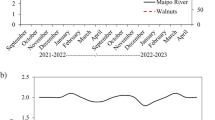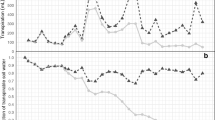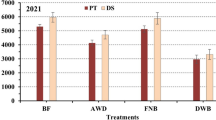Abstract
The high demand for walnuts in recent years may be related to trends towards the adoption of a healthy and balanced diet. Walnut production is seeking higher yields, early entry into production and kernel quality, with technologies that combine new cultivars, mechanical harvesting, more intensive plant density, and modern irrigation systems. The walnut crop has expanded to non-traditional growing areas, some of which have semiarid climates characterized by low water availability for irrigation. This mini-review focuses on the possible effects of water deficit on plant physiology, kernel yield and quality, based on a comprehensive and comparative analysis of existing information on other dry fruit crops. Some studies estimate the maximum water demand of the walnut at about 1050–1200 mm ha−1 yr−1 with an average seasonal crop coefficient of 0.9, varying according to the phenological stage and agroclimatic characteristics Indicators of water status such as water potential, stomatal conductance, and leaf temperature are evaluated. Sustained and regulated deficit irrigation in walnuts allows a considerable reduction in vegetative growth, with little effect on production while maintaining midday stem water potential above – 0.8 MPa. There are reports of disadvantages to kernel and oil quality mediated by environmental conditions where the water deficit influence requires further study.

Similar content being viewed by others
References
Adu MO, Yawson DO, Armah FA, Asare PA, Frimpong KA (2018) Meta-analysis of crop yields of full, deficit and partial root-zone drying irrigation. Agric Water Manag 197:79–90. https://doi.org/10.1016/j.agwat.2017.11.019
Allen RG, Pereira LS, Raes D, Smith M (1998) Crop evapotranspiration - Guidelines for computing crop water requirements - FAO Irrigation and Drainage Paper No. 56:1–15. http://www.fao.org/3/x0490e/x0490e00.htm
Archer P, Cohen M, Améglio T, Valancogne C, Antón A (2001) Trunk diameter variations in relation to walnut water potential. Acta Hortic 562:47–53. https://doi.org/10.17660/ActaHortic.2001.562.4
Bellvert J, Adeline K, Baram S, Pierce L, Sanden BL, Smart DR (2018) Monitoring crop evapotranspiration and crop coefficients over an almond and pistachio orchard throughout remote sensing. Remote Sens 10:2001. https://doi.org/10.3390/rs10122001
Bernard A, Lheureux F, Dirlewange E (2018) Walnut: past and future of genetic improvement. Tree Genet Genomes 14(1):1–28. https://doi.org/10.1007/s11295-017-1214-0
Buchner RP, Fulton AE, Gilles CK et al (2008) Effects of regulated deficit irrigation on walnut grafted on “Northern California Black” or “Paradox” rootstock. Acta Hortic 795:141–146. https://doi.org/10.17660/ActaHortic.2008.792.14
Carbonell-Barrachina ÁA, Memmi H, Noguera-Artiaga L, Gijón-López MDC, Ciapa R, Pérez-López D (2015) Quality attributes of pistachio nuts as affected by rootstock and deficit irrigation. J Sci Food Agric 95:2866–2873. https://doi.org/10.1002/jsfa.7027
Chalmers DJ, Mitchell PD, van Heek L (1981) Control of peach tree growth and productivity by regulated water supply, tree density and summer pruning. J Am Soc Hortic Sci 106:307–312 (ISSN: 0003-1062)
Charrier G, Bonhomme M, Lacointe A, Améglio T (2011) Are budburst dates, dormancy and cold acclimation in walnut trees (Juglans regia L.) under mainly genotypic or environmental control? Int J Biometeorol 55:763–774. https://doi.org/10.1007/s00484-011-0470-1
Christopoulos MV, Tsantili E (2011) Effects of temperature and packaging atmosphere on total antioxidants and colour of walnut (Juglans regia L.) kernels during storage. Sci Hortic 131:49–57. https://doi.org/10.1016/j.scienta.2011.09.026
Cochard H, Vanisse JS, Barigah TS et al (2007) Putative role of aquaporins in variable hydraulic conductance of leaves in response to light. Plant Physiol 143:122–133. https://doi.org/10.1104/pp.106.090092
Cohen M, Valancogne C, Dayau S, Ameglio T, Cruiziat P, Archer P (1997) Yield and physiological responses of walnut trees in semi-arid conditions: applications to irrigation scheduling. Acta Hortic 449:273–280. https://doi.org/10.17660/ActaHortic.1997.449.39
Dhillon R, Rojo F, Upadhyaya SK, Roach J, Coates R, Delwiche M (2019) Prediction of plant water status in almond and walnut trees using a continuous leaf monitoring system. Precis Agric 20:723–745. https://doi.org/10.1007/s11119-018-9607-0
Doorenbos J, Pruitt WO (1992) Crop water requirements. Food and Agriculture Organization of the United Nations Guidelines for predicting water requirements. FAO irrigation and drainage paper No 24. FAO, Rome (ISBN 92–5–104219–5)
Drechsler K, Fulton A, Kisekka I (2022) Crop coefficients and water use of young almond orchards. Irr Sci 40:379–395. https://doi.org/10.1007/s00271-022-00786-y
Drew DM, Downes GM (2009) The use of precision dendrometers in research on daily stem size and wood property variation: a review. Dendrochronologia 27:159–172. https://doi.org/10.1016/j.dendro.2009.06.008
FAOSTAT. 2020. Statistical database. [Rome]: FAO, c1997-. Retrieved from https://www.fao.org/faostat
Ferreyra ER, Sellés Van SG, Sellés MI (2001) Boletin INIA N°58: Riego deficitario controlado en nogales. Estrategias de riego para enfrentar situaciones de escasez de agua en frutales. Santiago, Chile: Instituto de Investigaciones Agropecuarias. https://biblioteca.inia.cl/handle/123456789/7563
Fields RP, Donis-Gonzales IR, Lampinen B, Crisosto CH (2020) Late maturity and excess irrigation trigger kernel darkening in ʻHowardʼ English walnut (Juglans regia L.) at harvest, but not in ʻChandlerʼ. J Am Pomol Soc 74:135–145
Fulton A, Buchner R, Olson B, Schwankl L, Gilles C, Bertagna N, Walton J, Shackel K (2001a) Rapid equilibration of leaf and stem water potential under field conditions in almonds, walnuts, and prunes. Hortechnology 11:609–615. https://doi.org/10.21273/HORTTECH.11.4.609
Fulton A, Buchner R, Little D, Gilles C (2001b) Shoot growth response of third leaf Howard walnuts to midday stem water potential. Walnut Res Rep 2001:151–155
Fulton A, Grant J, Buchner R, Connel J (2014) Using the pressure chamber for irrigation management in walnut, almond, and prune. ANR Publication. https://doi.org/10.3733/ucanr.8503
Fulton AE, Little CC, Snyder RL, Lampinen BD, Buchner RP (2017) Evaluation of crop coefficients and evapotranspiration in English walnut. ASABE Annu Int Meet. https://doi.org/10.13031/aim.201701457
García-Tejero IF, Hernández A, Rodríguez VM, Ponce JR, Ramos V, Muriel JL, Durán-Zuazo VH (2015) Estimating almond crop coefficients and physiological response to water stress in semiarid environments (SW Spain). J Agric Sci Tech 17:1255–1266
Gharaghani A, Javarzari AM, Vahdati K (2018) Kaolin particle film alleviates adverse effects of light and heat stresses and improves nut and kernel quality in Persian walnut. Sci Hortic 239:35–40. https://doi.org/10.1016/j.scienta.2018.05.024
Gispert JR, Tous J, Romero A, Plana J, Gil J, Company J (2004) The influence of different irrigation strategies and the percentage of wet soil volume on the productive and vegetative behaviour of the hazelnut tree (Corylus avellana L.). Acta Hortic 686:333–342. https://doi.org/10.17660/ActaHortic.2005.686.47
Goldhamer DA (2005) Tree water requirements and regulated deficit irrigation. In: Ferguson L (ed) Pistachio production manual, 4th edn. University of California, Fruit and Nut Research and Information Center, Davis, pp 103–116
Goldhamer DA, Beede R, Sibbett S et al (1988) Third year effects of deficit irrigation on walnut tree performance. Walnut Res Rep 1988:42–52
Goldhamer DA, Phene RC, Bedee R, DeJong TM, Ramos D (1985) Water use requirements of high and conventional density walnut orchards. Walnut Res Reports. pp. 26–29
Goldhamer DA (1998) Irrigation scheduling for walnut orchards. In: Ramos D (ed). Walnut production manual (1st edition), University of California Division of Agriculture and Natural Resources, Oakland, California
Howell TA (2001) Enhancing water use efficiency in irrigated agriculture. Agron J 93:281–289. https://doi.org/10.2134/agronj2001.932281x
Hsiao TC (1973) Plant responses to water stress. Ann Rev Plant Physiol 24:519–570. https://doi.org/10.1146/annurev.pp.24.060173.002511
Iglesias I, Echeverria G (2022) Current situation, trends, and challenges for efficient and sustainable peach production. Sci Hortic 296:110899. https://doi.org/10.1016/j.scienta.2022.110899
INDEC (Instituto Nacional de Estadística y Censos) (2020) Censo Nacional Agropecuario 2018. Resultados preliminares. Agricultura. Ministerio de Economía de la Nación, Buenos Aires, Argentina. https://I2018.indec.gob.ar/
Jackson RD, Idso SB, Reginato RJ, Pinter PJ (1981) Temperature as a crop water stress indicator. Water Resour Res 17:1133–1138. https://doi.org/10.1029/WR017i004p01133
Jensen PN, Sørensen G, Engelsen SB, Bertelsen G (2001) Evaluation of quality changes in walnut kernels (Juglans regia L.) by Vis/NIR Spectroscopy. J Agric Food Chem 49:5790–5796. https://doi.org/10.1021/jf010509t
Jones HG (2004) Irrigation scheduling: advantages and pitfalls of plant-based methods. J Exp Bot 55:2427–2436. https://doi.org/10.1093/jxb/erh213
Jones HG, Serraj R, Loveys BR, Xiong L, Wheaton A, Price AH (2009) Thermal infrared imaging of crop canopies for remote diagnosis and quantification of plant responses to water stress in the field. Funct Plant Biol 36:978–989. https://doi.org/10.1071/FP09123
Jovanovic Z, Stikic R (2018) Partial root-zone drying technique: from water saving to the improvement of a fruit quality. Front Sustain Food Syst 1:3. https://doi.org/10.3389/fsufs.2017.00003
Kanber R, Önder S, Köksal H (1993) Irrigation response of pistachio (Pistacia vera L). Irr Sci 14:7–14. https://doi.org/10.1007/BF00195000
Kishore K, Singh HS, Kurian RM (2015) Paclobutrazol use in perennial fruit crops and its residual effects: a review. Indian J Agric Sci 85:863–872
Kozlowski TT, Pallardy SG (2002) Acclimation and adaptive responses of woody plants to environmental stresses. Bot Rev 68:270–334. https://doi.org/10.1663/0006-8101
Lampinen B, Buchner R, Fulton A, Grant J et al (2004) Irrigation management in walnut using evapotranspiration, soil and plant based data. Calif Walnut Board 24:113–136
Lang MD, Sulcs JA, Evans KJ (2014) Loss of kernel quality associated with harvest delays in Tasmania, Australia. Acta Hortic 1050:309–314. https://doi.org/10.17660/ActaHortic.2014.1050.42
Lemus G (2010) Innovative methods of walnut production in South America. Acta Hortic 861:191–198. https://doi.org/10.17660/ActaHortic.2010.861.25
Lipan L, Martín-Palomo MJ, Sánchez-Rodríguez L et al (2019) Almond fruit quality can be improved by means of deficit irrigation strategies. Agric Water Manag 2179:236–242. https://doi.org/10.1016/j.agwat.2019.02.041
Liu B, Lian J, Tang G, Wang X, Liu F, Zhao D (2019) Drought stress affects on growth, water use efficiency, gas exchange and chlorophyll fluorescence of Juglans rootstocks. Sci Hortic 250:230–235. https://doi.org/10.1016/j.scienta.2019.02.056
Luedeling E, Zhang M, McGranahan G, Leslie C (2009) Validation of winter chill models using historic records of walnut phenology. Agric for Meteorol 149:1854–1864. https://doi.org/10.1016/j.agrformet.2009.06.013
Mahmoudian M, Rahemi M, Karimi S et al (2021) Role of kaolin on drought tolerance and nut quality of Persian walnut. J Saudi Soc Agric Sci 20:409–416. https://doi.org/10.1016/j.jssas.2021.05.002
McCutchan H, Shackel KA (1992) Stem-water potential as a sensitive indicator of water stress in prune trees (Prunus domestica L. cv. French). J Am Soc Hortic Sci 117(4):607–611. https://doi.org/10.21273/JASHS.117.4.607
Meinzer FC (1993) Stomatal control of transpiration. Tree 8:289–294. https://doi.org/10.1016/0169-5347(93)90257-P
Mingeau M, Rousseau P (1994) Water use of hazelnut trees as measured with lysimeters. Acta Hortic 351:315–322. https://doi.org/10.17660/ActaHortic.1994.351.34
Miyamoto S, Henggeler J, Benton Storey J (1995) Water management in irrigated pecan orchards in the Southwestern United States. Hortechnology 5:214–218. https://doi.org/10.21273/HORTTECH.5.3.214
Morabito JS, Salatino C, Mirábile Y, Guillén D (2006) Riego por micro aspersión de nogal en Chilecito, La Rioja: Necesidades de riego y estrategias de manejo (2da parte). Mendoza: III Jornada de Actualización en Riego y Fertirriego (Instituto Nacional del Agua).
Ortega-Farias S, Villalobos-Soublett E, Riveros-Burgos C, Zúñiga M, Ahumada-Orellana LE (2020) Effect of irrigation cut-off strategies on yield, water productivity and gas exchange in a drip-irrigated hazelnut (Corylus avellana L. cv. Tonda di Giffoni) orchard under semiarid conditions. Agric Water Manag 238:106173. https://doi.org/10.1016/j.agwat.2020.106173
Ortiz CM, Vicente AR, Fields RP et al (2019) Postharvest biology and technology walnut (Juglans regia L.) kernel postharvest deterioration as affected by pellicle integrity, cultivar and oxygen concentration. Postharvest Biol Technol 156:1–8. https://doi.org/10.1016/j.postharvbio.2019.110948
Pérez-López D, Memmi H, Gijón-López MC et al (2018) Irrigation of pistachios: strategies to confront water scarcity. In: García-Tejero IF, Duran Zuazo VH (eds) Water scarcity and sustainable agriculture in semiarid environment, 1st edn. Academic, Cambridge, Massachusetts, pp 247–269
Pollegioni P, Woeste K, Chiocchini F et al (2017) Rethinking the history of common walnut (Juglans regia L.) in Europe: its origins and human interactions. PLoS ONE 12:1–24. https://doi.org/10.1371/journal.pone.0172541
Ramos D, Brown L, Uriu K, Marangoni B (1978) Water stress affects size and quality of walnuts. Calif Agric 32(10):5–8
Romero R, Muriel JL, García I (2009) Automatic irrigation system in almonds and walnuts trees based on sap flow measurements. Acta Hortic 846:135–142. https://doi.org/10.17660/ActaHortic.2009.846.13
Rosati A, Metcalf S, Buchner R, Fulton A, Lampinen B (2006) Tree water status and gas exchange in walnut under drought, high temperature and vapor pressure deficit. J Hortic Sci Biotechnol 81:415–420. https://doi.org/10.1080/14620316.2006.11512082
Rubí Bianchi A, Cravero SAC (2010) Atlas climático digital de la República Argentina, 1st edn. Instituto Nacional de Tecnología Agropecuaria, Buenos Aires
Ruiz-Sánchez MC, Domingo R, Castel JR (2010) Review. Deficit irrigation in fruit trees and vines in Spain. Span J Agric Res 8:5–20. https://doi.org/10.5424/sjar/201008S2-1343
Sadras VO (2009) Does partial root-zone drying improve irrigation water productivity in the field? A meta-analysis. Irr Sci 27:183–190. https://doi.org/10.1007/s00271-008-0141-0
Sakr S, Alves G, Morillon R et al (2003) Plasma membrane aquaporins are involved in winter embolism recovery in walnut tree. Plant Physiol 133(2):630–641. https://doi.org/10.1104/pp.103.027797
Samani Z, Bawazir S, Skaggs R, Longworth J, Piñon A, Tran V (2011) A simple irrigation scheduling approach for pecans. Agric Water Manag 98:661–664. https://doi.org/10.1016/j.agwat.2010.11.002
Sammis TW, Mexal JG, Miller D (2004) Evapotranspiration of flood-irrigated pecans. Agric Water Manag 69:179–190. https://doi.org/10.1016/j.agwat.2004.05.005
Sánchez-González C, Ciudad CJ, Noé V, Izquierdo-Pulido M (2017) Health benefits of walnut polyphenols: an exploration beyond their lipid profile. Critical Rev Food Sci Nut 57:3373–3383. https://doi.org/10.1080/10408398.2015.1126218
Scholander PF, Hammel HT, Bradstreet ED, Hemmingsen EA (1965) Sap pressure in vascular plants negative hydrostatic pressure can be measured in plants. Science 148:339–346. https://doi.org/10.1126/science.148.3668.339
Searles PS, Alcarás MA, Rousseaux MC (2011) Water use by olive orchards (Olea europaea L.) in the Northwest of Argentina: a comparison with the Mediterranean Basin. Ecol Austral 21:15–28
Sparks D (2005) Adaptability of pecan as a species. HortScience 40:1175–1189. https://doi.org/10.21273/HORTSCI.40.5.1175
Sperry JS, Alder NN, Eastlack SE (1993) The effect of reduced hydraulic conductance on stomatal conductance and xylem cavitation. J Exp Bot 44:1075–1082. https://doi.org/10.1093/jxb/44.6.1075
Steduto P, Hsiao TC, Fereres E, Raes D (2012) Crop yield response to water. FAO Irrigation and Drainage Paper No. 66. FAO, Rome
Stevens RM, Ewenz CM, Grigson G, Conner SM (2012) Water use by an irrigated almond orchard. Irr Sci 30:189–200. https://doi.org/10.1007/s00271-011-0270-8
Trentacoste ER, Calderón FJ, Contreras-Zanessi O et al (2019) Effect of regulated deficit irrigation during the vegetative growth period on shoot elongation and oil yield components in olive hedgerows (cv. Arbosana) pruned annually on alternate sides in San Juan, Argentina. Irr Sci 37:533–546. https://doi.org/10.1007/s00271-019-00632-8
Vahdati K (2014) Traditions and folks for walnut growing around the silk road. Acta Hortic 1032:19–24. https://doi.org/10.17660/ActaHortic.2014.1032.1
Wei F, Chen Q, Du Y et al (2020) Effects of hulling methods on the odor, taste, nutritional compounds, and antioxidant activity of walnut fruit. LWT - Food Sci Technol 120:108938. https://doi.org/10.1016/j.lwt.2019.108938
Yahmed JB, Ghrab M, Mimoun MB (2016) Eco-physiological evaluation of different scion-rootstock combinations of almond grown in Mediterranean conditions. Fruits 71:185–193. https://doi.org/10.1051/fruits/2016003
Acknowledgements
This work is part of a thesis submitted by FEC in partial fulfillment for the requirements for the PhD degree (Facultad de Ciencias Agrarias, Universidad Nacional de Cuyo, Mendoza, Argentina). We are grateful to Silvia Barbuzza for her help with proofreading.
Funding
This work was supported by grants from Consejo Nacional de Investigaciones Científicas y Técnicas (CONICET) (pre-doctoral fellowship 4199/17).
Author information
Authors and Affiliations
Contributions
All authors contributed to the study conception and design. Material preparation, data collection and analysis were performed by FEC, STS and ERT. The first draft of the manuscript was written by FEC, and all authors commented on previous versions of the manuscript. All authors read and approved the final manuscript.
Corresponding author
Ethics declarations
Conflict of interest
The authors have no relevant financial or non-financial interests to disclose.
Additional information
Publisher's Note
Springer Nature remains neutral with regard to jurisdictional claims in published maps and institutional affiliations.
Rights and permissions
Springer Nature or its licensor holds exclusive rights to this article under a publishing agreement with the author(s) or other rightsholder(s); author self-archiving of the accepted manuscript version of this article is solely governed by the terms of such publishing agreement and applicable law.
About this article
Cite this article
Calvo, F.E., Silvente, S.T. & Trentacoste, E.R. A mini review of the impacts of deficit irrigation strategies for walnut (Juglans regia L.) production in semiarid conditions. Irrig Sci 41, 501–509 (2023). https://doi.org/10.1007/s00271-022-00815-w
Received:
Accepted:
Published:
Issue Date:
DOI: https://doi.org/10.1007/s00271-022-00815-w




